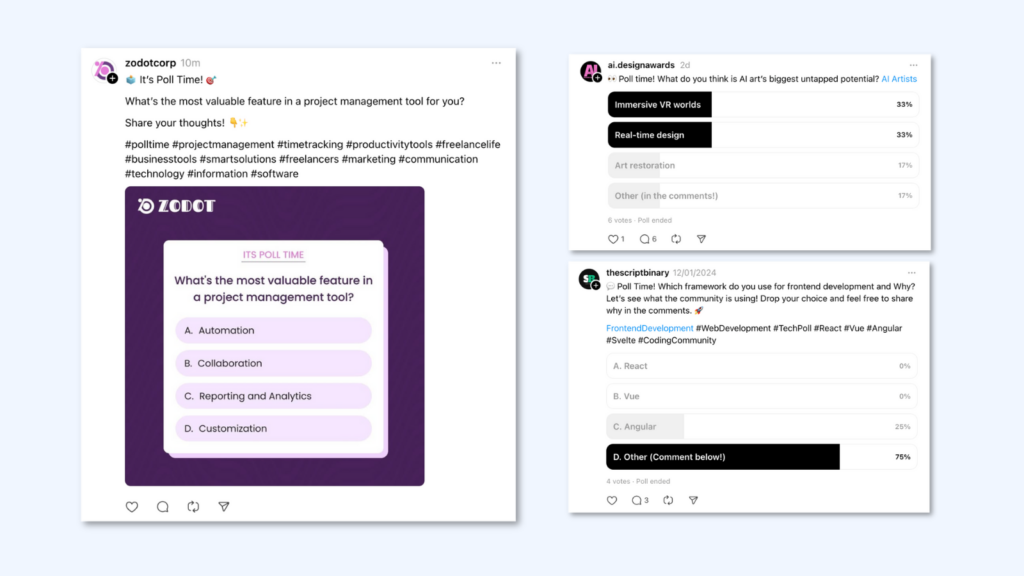No other marketing channel lets you reach a massive audience while getting personal with your audience, like social media marketing. Thus, we see continuous efforts from brands to invest in it. To be exact, SproutSocial reveals in recent data that 96% of business leaders expressed the continuous need to invest in it to succeed online.
However, with algorithms constantly changing and audiences’ tastes also evolving, leveraging the platform for marketing demands staying abreast of trends and adapting accordingly. From generative AI’s impact on content production and consumption to refined messaging, these changes in technology and consumer behavior direct social media strategies across industries.
If you want to double down on your efforts to market on the platform in the coming year, this list of top social media strategies for 2025 is just the read for you.
Generative AI, Social Media, and Audience Behavior Shifts
In 2024, social media saw so many changes thanks primarily to, you guessed it, generative AI. So, in 2025, the trends you’ll read about likely have their underpinnings on the technology’s influence, for better or worse.
From ballooning the rate of content creation to empowering innovation in content style and treatments, the response to it is a shift in the practice of social media marketing in every aspect. To respond to it with effective strategies entails understanding its ripple effects.
- Understanding how audiences enjoy content will be critical. Any kind of content, no matter how well-made, is useless unless it resonates with your audience. That implies that being able to create content rapidly with AI doesn’t suggest creating haphazardly. Instead, maintaining intention is critical, regardless of whether you want to entertain, educate, or engage. Think about your content’s message, medium, and delivery. Does it align with your audience’s interests? If not, it might be wise to scrap it.
- People want to be entertained, not sold to. Thanks to the rise of TikTok, short-form, creative videos have become the most popular way of delivering a message online. As brands tap more creators specializing in entertaining skits or POV sketches, entertainment becomes the most popular (if not the new norm) for connecting with audiences. However, there is a caveat to note here. While entertainment does work, brand alignment must be considered. If your brand voice and tone are not entertaining, it can confuse your audiences rather than impress them.
- Keep it original and unique. Uniqueness and originality are among the resulting demands of online audiences tired of overdone content themes and messages. Additionally, generative AI’s inability to nuance its writing has led to “redundancies” and a “genericness” that users spot and reject quickly. Thus, when creating social media content, push for innovation and think of new ways to communicate your message. It may take more effort, but the rewards are worth it, as 34% of consumers buy something from brands that post original content.
The main takeaway from these developments is that the widespread adoption of generative AI has pushed the boundaries for social media strategies in every way possible. From the business perspective, it has increased productivity unlike ever before. Meanwhile, compromising quality is now unacceptable for an increasing number of audiences.
Effective social media marketing in 2025 will rely on how well you adapt to this. In the next section, we’ll show you some specific approaches you can explore to do so.
Social Media Strategies to Explore for 2025
With the developments discussed above, we have a solid frame of reference for creating social media content in 2025. Layering the other important aspects of social media content creation, we delve into specifics for potential executions below, all while keeping in mind the importance of maintaining originality, intention, and high-quality standards.
1. Prioritizing Personalization and User-Centric Content
AI tools have become indispensable for creating content quickly. However, marketers have yet to learn how to leverage them to hyper-personalize the content they post.
To see better results from AI and social media strategies in 2025, seek to explore personalization by using technology to understand your audiences better. Use AI to dissect audience behaviors, preferences, and interactions and tailor content accordingly.
Platforms now offer advanced analytics and AI-driven algorithms to achieve this. Seek to analyze these insights and customize content to resonate better with your audiences. Explore approaches like tailored product recommendations or curated posts that address specific interests.
For example, AI chatbots integrated into social media platforms can answer user queries in real-time, creating a seamless customer service experience. Personalization at this level boosts engagement and builds trust, as users feel understood and valued.
2. Don’t Just Engage — Involve Audiences via Interactive Content
Engaging your audience is no longer just about posting attractive visuals or catchy captions. Interactive content, such as polls, quizzes, and live Q&A sessions, fosters meaningful connections and keeps audiences returning.

Tools like Instagram Stories and LinkedIn polls make it easy for brands to invite participation, turning passive followers into active participants. For instance, hosting a live Q&A about a product launch can build anticipation while addressing customer concerns in real-time. These interactions provide valuable insights into audience preferences while reinforcing brand loyalty.
2. Your Videos Should be Kept Short and Sweet
Short-form videos remain a cornerstone of social media strategies. Platforms like TikTok, Instagram Reels, and YouTube Shorts have revolutionized content consumption by delivering bite-sized, engaging videos that capture attention instantly.
Research shows that videos between 15 and 30 seconds tend to perform best on these platforms. These formats align with users’ short attention spans while still delivering impactful messaging. They are ideal for storytelling, showcasing products, or creating viral trends.
Brands should prioritize creating authentic, relatable content that aligns with platform trends. For instance, trending music or challenges can increase visibility, while incorporating a clear call-to-action ensures the content drives measurable results. By keeping videos concise and focused, businesses can maximize engagement and leave a lasting impression.
3. Live-streaming is Still Cool and Creates Real-Time Engagement
Live video continues to grow as a powerful tool for building trust and fostering authentic connections. Platforms such as Facebook Live, TikTok Live, and YouTube Live enable brands to interact with audiences in real-time, whether through product demonstrations, behind-the-scenes glimpses, or live events.
Live streaming allows businesses to showcase their human side, creating a sense of transparency and immediacy. Hosting live product launches or tutorials also creates a sense of exclusivity, encouraging viewers to tune in and engage directly with the brand.
4. Integrating E-Commerce Features Across Platforms
Social commerce is no longer optional—it’s necessary for businesses looking to streamline the path from discovery to purchase. Platforms like Instagram, Facebook, and Pinterest have introduced advanced shopping features, such as in-app checkout, product tags, and shoppable posts.
To succeed in social commerce, brands should optimize their product listings with high-quality visuals, clear descriptions, and seamless navigation. Creating themed collections or offering exclusive discounts through social media can further enhance the shopping experience.
5. Engage Influencers for Social Commerce
Influencers play a vital role in amplifying brand visibility and driving purchases. Their authentic connections with niche audiences make them effective partners for promoting products in ways that feel organic.
In 2025, micro and nano influencers with smaller but highly engaged followings will be particularly valuable. Collaborating with these influencers allows brands to tap into specific communities and achieve higher conversion rates than broader campaigns.
6. Expanding Reach Through Niche Platforms and Communities
While established platforms dominate the social media landscape, emerging platforms create fresh opportunities for businesses to connect with audiences. Apps like BeReal and Clubhouse have gained momentum by offering unique user experiences that resonate with younger audiences and niche demographics. For brands, these platforms present a chance to stand out by experimenting with creative content tailored to their distinct formats, establishing an early presence that could pay off as these platforms grow.
At the same time, private groups and micro-communities are on the rise, driven by users’ desire for more intimate and value-driven interactions. Platforms like Facebook Groups, Discord servers, and LinkedIn Communities provide businesses with the tools to build deeper connections with their audiences. By creating exclusive spaces for fans or customers, brands can offer tailored content, address questions directly, and gather meaningful feedback.
These communities also have the added advantage of fostering organic advocacy. Loyal members often become brand ambassadors within their networks, amplifying your message through word-of-mouth marketing. Embracing both emerging platforms and micro-communities allows businesses to expand their reach while cultivating authentic relationships with their audience.
7. Enhancing Data Privacy and Ethical Marketing Practices
Users are becoming increasingly cautious about the ads they engage with, making transparency and authenticity non-negotiable for brands. Clear, honest messaging builds credibility and helps businesses comply with ever-changing advertising regulations. Brands that prioritize openness in their marketing are more likely to earn consumer trust, fostering long-term relationships and loyalty.
Data privacy laws, such as GDPR and CCPA, continually evolve, and businesses must stay compliant to avoid penalties and safeguard their reputations. This requires ethical data collection practices that respect user privacy while supporting marketing goals. Offering value-driven opt-ins, like free resources or exclusive discounts, can encourage users to share their information willingly, creating a win-win situation.
Regular data collection and storage process audits are essential to ensure compliance with the latest privacy regulations. By staying transparent and proactive, businesses can align with both legal requirements and consumer expectations, building trust and credibility in a privacy-conscious digital landscape.
Final Thoughts: Winning the Social Media Game in 2025
Succeeding in social media in 2025 requires more than adapting to trends—it requires anticipating changes and aligning your strategies with user expectations. From prioritizing personalization to leveraging video and fostering trust, these strategies provide a roadmap for navigating the evolving digital landscape.
While projections and tools can guide your efforts, staying innovative and flexible will ultimately determine your success.
If you want to elevate your social media game in 2025, give The Ad Firm team a call, and let us provide you with strategic insights and tools needed to thrive. Let us help you transform your social media presence into a powerful driver of growth and engagement.









